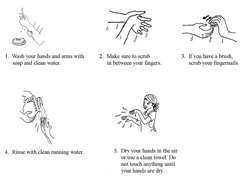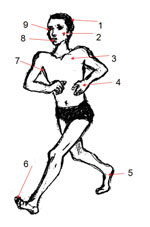Use 'Print preview' to check the number of pages and printer settings.
Print functionality varies between browsers.
Printable page generated Tuesday, 23 April 2024, 3:35 PM
Hygiene and Environmental Health Module: 3. Personal Hygiene
Study Session 3 Personal Hygiene
Introduction
The exercise of proper personal hygiene is one of the essential parts of our daily life. Many people in rural areas may not understand what good or bad personal hygiene is. The prevention of communicable diseases, like diarrhoea, trachoma and many others is highly possible through the application of proper personal hygiene. You need to learn the proper practice of personal hygiene and use this for the prevention and control of important public health diseases that are prevalent in your locality. This study session will also help you to understand the links between personal hygiene and one’s dignity, confidence and comfort.
Learning Outcomes for Study Session 3
When you have studied this session, you should be able to:
3.1 Define and use correctly each of the key words printed in bold.(SAQ 3.1)
3.2 Describe the public health importance of personal hygiene. (SAQ 3.3)
3.3 List and describe the components of personal hygiene. (SAQs 3.1 and 3.2)
3.4 Describe what are acceptable and poor personal hygiene practices. (SAQ 3.4)
3.5 Prioritise the components of personal hygiene that are critical for public health concerns. (SAQ 3.3)
3.6 Explain hygienic handwashing using standard procedures, and list the critical situations for effective handwashing. (SAQs 3.4 and 3.5)
3.7 Explain the elements and activities that are needed for planning personal hygiene promotion. (SAQ 3.6)
3.8 Describe the criteria that are used for evaluating the effectiveness of personal hygiene application. (SAQ 3.7)
3.1 What is personal hygiene?
Personal hygiene is a concept that is commonly used in medical and public health practices. It is also widely practised at the individual level and at home. It involves maintaining the cleanliness of our body and clothes. Personal hygiene is personal, as its name implies. In this regard, personal hygiene is defined as a condition promoting sanitary practices to the self. Everybody has their own habits and standards that they have been taught or that they have learned from others. Generally, the practice of personal hygiene is employed to prevent or minimise the incidence and spread of communicable diseases.
3.2 Difference between cleanliness and hygiene
The term cleanliness should not be used in place of hygiene. Cleaning in many cases is removing dirt, wastes or unwanted things from the surface of objects using detergents and necessary equipment. Hygiene practice focuses on the prevention of diseases through the use of cleaning as one of several inputs. For example, a janitor cleans the floor of a health centre using detergent, mop and broom. They might also use chlorine solution to disinfect the floor. The cleaning process in this example is the removal of visible dirt, while the use of chlorine solution removes the invisible microorganisms. Hygienic practice encompasses both cleaning for the removal of physically observable matters and the use of chlorine for the removal of microorganisms. The hygiene practice in this example aims at preventing the spread of disease-causing organisms. Cleaning is a means to achieve this task.
3.3 Public health importance of personal hygiene
The knowledge and practice of personal hygiene are vital in all our everyday activities. The purposes are:
Preventing faeco-orally transmitted diseases
The fingers may get contaminated with one’s own faeces, either directly or indirectly. Activities during defecation and child bottom-washing are additional opportunities for the contamination of the fingers that facilitate the transmission of infections.
Aesthetic values of personal hygiene
A person with clean hands is proud while eating because they feel confident of preventing diseases. A teacher in a school is always happy to see their students with clean faces and eyes, and dressed in clean clothes. A mother is mentally satisfied to feed her infant with clean hands because she ensures the preservation of her child’s health. Generally, cleaning oneself produces pride, comfort and dignity at home and in public places. Caring about the way you look is important to your self-esteem.
Social impact
A person with poor personal hygiene might be isolated from friendship because telling the person about the situation might be sensitive and culturally difficult. The success of a job application or the chance of promotion could be affected by poor personal hygiene; no company wants to be represented by someone who does not appear to be able to look after themselves.
3.4 Components of personal hygiene
3.4.1 Body hygiene (skin care)
The body has nearly two million sweat glands. Moistened and dried sweat and dead skin cells all together make dirt that sticks on to the skin and the surface of underclothes. The action of bacteria decomposes the sweat, thereby generating bad odour and irritating the skin. This is especially observed in the groin, underarms and feet, and in clothing that has absorbed sweat. Skin infections such as scabies, pimples and ringworm are results of poor body hygiene. Figure 3.1 shows ringworm of the scalp (Tinea capitis).
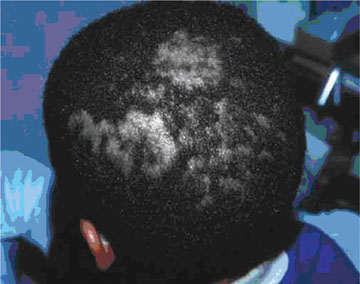
The first task in body hygiene is to find water, soap and other cleansing materials. Taking a bath or a shower using body soap at least weekly is very important to ensuring our body stays clean (Figure 3.2). Bathing can be every day or after periods of sweating or getting dirty. The genitals and the anal region need to be cleaned well because of the natural secretions of these areas. Dry the body with a clean towel after thorough rinsing. Change into clean underwear after a bath. Changing sweat-soaked clothes after each bath is advised. Cleaning the ears after every bath is also necessary. Avoid sharing soaps and towels because of the danger of cross-infection.
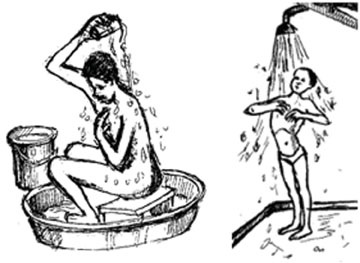
3.4.2 Oral hygiene (oral care)
The mouth is the area of the body most prone to collecting harmful bacteria and generating infections. Our mouth mechanically breaks food into pieces. This process leaves food particles (food debris) that stick to the surface of our gums and teeth. Our mouth cavity is full of bacteria and is a good environment for bacterial growth.
Why is the mouth a good environment for bacterial growth?
It is at the optimum temperature (37ºC) and is often rich in food particles that support bacterial growth.
The decaying process that takes place on the surface of the teeth eventually produces a build-up called plaque (a sticky deposit on which bacteria grow) that is then converted into tartar (a hard, yellowish, calcified deposit on the teeth, consisting of organic secretions and food particles). The result is tooth decay. In addition, unpleasant smelling breath (halitosis or stinking odour), teeth and gum infections could be a result of poor oral hygiene.
Advice for keeping the mouth clean (Figure 3.3) is:
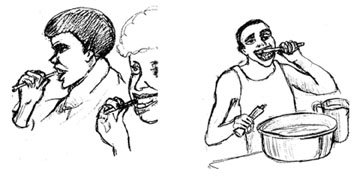
- Rinse the mouth after each meal.
- Brush your teeth with a fluoride-containing toothpaste twice a day – before breakfast and before you go to bed. Cleaning the mouth with twigs is possible if done carefully.
- During the day, fill your mouth with water and swish it around to get rid of anything sticking to your teeth.
- In addition to regular brushing, it is advisable to floss your teeth at least once a day, usually before you go to bed.
3.4.3 Handwashing (hand care)
The cleanliness of our hands is very important in all our daily activities. In our normal activities our hands frequently get dirty. There are many situations in which microorganisms are likely to attach to our hands along with the dirt. There are many communicable diseases that follow the route of faeco-oral transmission. Hand hygiene plays a critically important role in preventing this transmission.
Hygienic handwashing involves the mechanical removal of microorganisms from contaminated hand surfaces using soap or detergent. Handwashing should involve more than a quick rinse under a tap (faucet) or in running water.
The following handwashing technique (also shown in Figure 3.4) ensures that the hands are properly washed and it doesn’t take long to complete:
- First wet your hands with clean water and lather with a bar of soap.
- Next rub your hands together vigorously and scrub all surfaces up to your wrists.
- Clean under your fingernails.
- Continue for 15–30 seconds or about the length of a little tune (for example, the ‘Happy Birthday’ song). It is the soap combined with the scrubbing action that helps dislodge and remove germs.
- Rinse your hands well with clean running water (pour from a jug or tap).
- Dry your hands in the air to avoid recontamination on a dirty towel – do not touch anything until your hands are dry.
- Wood ash will also rub off any dirt and smells. The slight irritation you feel when you wash your hands with ash shows the cleansing power of ash.
- Local seeds such as indod (Lemma’s plant), which are known to be good cleaning agents, can also be used for regular handwashing.
- Clean sand with water can be used for handwashing to help to rub off dirt.
If you don’t have soap, you can use alternatives. These serve the same purpose as the soap, to help ‘scrub’ what is stuck on your hands, so the running water can brush it off. To get clean hands, you must POUR the water over your hands (no dipping in a bowl!). The soap or ash ‘lifts’ the dirt, and the water then washes off the visible dirt and the invisible germs. Various options for handwashing are indicated in Figure 3.5.
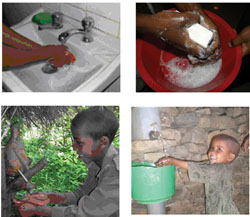
As well as routine personal hygiene that applies to everyone, your daily work will include many situations when you may ask yourself when you need to wash your hands. To know when to wash your hands at home and at work, you must first identify critical situations; that is, situations, activities or incidents that indicate the possibility that pathogenic microorganisms are present on hands, fingers and nail surfaces.
Critical situations in everyday activity include:
- After using the toilet (or disposing of human or animal faeces)
- After changing a baby’s diaper (nappy) and disposing of the faeces.
- Immediately after touching raw food when preparing meals (e.g. chicken or other meat).
- Before preparing and handling cooked/ready-to-eat food.
- Before eating food or feeding children.
- After contact with contaminated surfaces (e.g. rubbish bins, cleaning cloths, food-contaminated surfaces).
- After handling pets and domestic animals.
- After wiping or blowing the nose or sneezing into the hands (respiratory hygiene).
- After handling soiled tissues (your own or others’, e.g. children).
Critical situations in healthcare activity include:
- Before and after contact with an infected wound.
- After contact with blood or body fluids (e.g. vomit).
- Before and after dressing wounds.
- Before giving care to an ‘at risk’ person (e.g. attending delivery, attending a baby).
- After giving care to an infected person.
3.4.4 Face hygiene
Our face reveals our daily practice of personal hygiene. Face hygiene includes all parts of the face. The most important area to keep clean is the eyes. The eye discharges protective fluids that could dry and accumulate around the eye. They are visible when a person gets up in the morning. The organic substance of the eye discharge can attract flies and this is dangerous because the fly is a carrier (vector) of trachoma and conjunctivitis.
A person should wash their face every morning in order to remove all dirt that they have come in contact with during the course of the day. This will keep your face clean all day. Children are advised to wash their face frequently. Never share your face towel with others.
Why is it inadvisable to share a face towel?
Because some diseases, such as conjunctivitis and trachoma, can be transmitted easily from person to person in this way.
3.4.5 Fingernail and toenail hygiene (nail care)
A nail is hard tissue that constantly grows. Long fingernails tend to accumulate or trap dirt on the underside. The dirt could be as a result of defecation or touching infected and contaminated surfaces. Keeping nails trimmed and in good shape weekly is important in maintaining good health. Clip nails short along their shape but do not cut them so close that it damages the skin. Razor blades and fingernail cutters or scissors are used to cut nails. Nail cutters should not be shared with others.
Why is it inadvisable to share nail cutters?
Because some diseases, such as fungal infections, can be transmitted easily from person to person in this way.
3.4.6 Ear hygiene
Ear wax accumulates in the ear canal that leads from the outer ear to the ear drum. As the secretion comes out of the ear it collects dust particles from the air. Daily washing with soap and water is enough to keep the outer ear clean. Do not reach farther than you can with your little finger into your ear. Putting in hairpins, safety pins or blunt-edged things for cleaning purposes might harm the ear. If you feel wax has accumulated and is plugging your ears and interfering with hearing, consult your doctor.
3.4.7 Hair hygiene (hair care)
The hair follicles from which the hair grows produce oil from the sebaceous glands that keeps the hair smooth. The scalp (the skin covering the head) also has numerous sweat glands and is a surface for the accumulation of dead skin cells. The oil, sweat and dead cells all add together and can make the hair greasy and look dirty unless you wash it regularly.
Poor hair hygiene could cause dandruff and skin infections such as Tinea capitis (see Figure 3.1). Dandruff is dead skin on the scalp that comes off in tiny flakes when sebaceous glands produce too much oil and accumulates on the scalp.
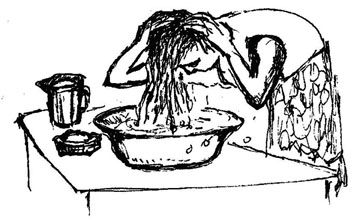
Head hair is a good harbour for head lice (Pediculus humanus capitis) and nits (eggs of head lice). The head louse is a tiny insect that lives by sucking blood. Children are especially prone to lice infestation. Lice spread from one head to another when there is close contact as in school environments. They make the scalp itchy and are a cause of annoyance, irritation and embarrassment. Shaving of the head hair is possible in cases of heavy lice infestation. Sharing of blades with others, however, should be discouraged.
Hair cleaning (Figure 3.6) is important to ensure it stays clean, healthy and strong.
The recommended procedures for cleaning the hair are:
- Use clean water to wash your hair regularly (at least twice weekly, preferably once every other day) with body soap or shampoo, whichever is available.
- Massage your scalp well. This will remove dead skin cells, excess oil and dirt.
- Rinse well with clear water.
- Conditioner is helpful if you have longer hair as it makes the hair smoother and easier to comb, but hair doesn’t need to have conditioner.
- Use a wide toothed comb for wet hair as it is easier to pull through.
- Dry the hair and the head with a clean towel. Never share a towel with someone else.
- Comb the hair to look beautiful for the day.
3.4.8 Foot hygiene (foot care)
We spend a lot of time on our feet. Our feet sweat as we walk day and night and the sweat accumulates on all foot surfaces and between the toes. The sweat may stain the shoes and can produce an awful odour.
What causes sweat on the skin to produce an unpleasant odour?
The action of bacteria as they decompose the sweat.
As well as bacteria, sweat also encourages fungal growth between the toes. This is called athlete’s foot. The symptoms of athlete’s foot are scaly skin and sores or blisters, which start between the toes but can often spread to the soles of the feet. This is a minor irritation and often disappears by itself but sometimes these cracks and sores become the site for other infections. The feet should be washed daily, or at least twice weekly.
Foot hygiene is also important in the treatment of podoconiosis, sometimes known as mossy foot. This disease causes swelling in the feet and lower legs and is common in certain parts of Ethiopia. It is a reaction in the body to very small soil particles that have passed through the skin of the feet. Podoconiosis can easily be prevented by wearing shoes at all times but, if someone is affected, careful washing and drying of the feet is an important part of the treatment.
Toenails do not have much role in the transmission of diseases. However, they can accumulate dirt and this can increase the potential for bacterial and fungal breeding e.g. athlete’s foot.
3.4.9 Armpit and bottom hygiene
These are body parts that easily get sweaty and where ventilation is very poor. After puberty, our sweat gains a specific and unpleasant odour which may be offensive to others. The armpits and the bottom should be washed daily.
Anal cleansing is the hygienic practice of cleaning the anus after defecation. The anus and buttocks may be cleansed with clean toilet paper or similar paper products. Water may be used. Hands must be washed with soap afterwards. The use of rags, leaves, stones, corn cobs, or sticks must be discouraged as these materials can damage the skin.
3.4.10 Clothes hygiene
We usually have two layers of clothing. The internal layer is underwear (or underclothes) such as pants, vest and T-shirt. These are right next to our skin and collect sweat and dead skin cells, which can stain the cloth. Bacteria love to grow on this dirt and produce a bad smell in addition to the specific odour of the sweat. Underwear must be washed more frequently than the outer layer of clothing.
Clothes hygiene is an important aspect of one’s dignity. Changing used clothes for clean ones every day is recommended. Washing dirty clothes requires adequate clean water, detergents (solid or powdered soap) and washing facilities (Figure 3.7). If possible, the washed clothes should be ironed to help the destruction of body lice and nits. Boiling water or insecticides can be used to destroy clothes infestation.
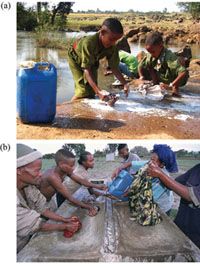
Frequent changing into clean clothes might not always be possible in poor households. However, the frequency of changing is advised to be twice a week for internal wear and 12 times per week for outerwear. The frequency mainly depends on the intensity of dirt on the clothes, and that depends on the climate and type of activity.
3.4.11 Menstrual hygiene (Personal hygiene for women)
The vagina is able to clean itself; no special care is needed other than washing the external genitals. Washing the outer genital area with clean water must be a daily practice. Change tampons and sanitary napkins or pads regularly. Always wash your hands before and after handling a tampon or pad. Clean and soft cloths can be used in place of sanitary pads. The use of dirty cloths must be discouraged. Menstrual blood-absorbing items must be properly disposed of in a burial pit or other appropriate method.
3.5 Planning for the improvement of personal hygiene
You will find further details of hygiene promotion activities in the Health Education, Advocacy and Community Mobilisation Module.
As a Health Extension Practitioner, educating the community members on personal hygiene is one of your main duties. You may ask yourself: what educating, educating whom, where, and how? You may further ask yourself: how do I monitor or evaluate my success in the promotion of personal hygiene? The following section will answer these questions.
3.5.1 Preparing a plan of action for personal hygiene promotion
You need to make a baseline survey of your community to help you understand the extent of personal hygiene problems. Villages and schools can be surveyed for this purpose. Designing a health survey will need collaboration with others but your input is valuable for structuring the questions so they relate to local knowledge, attitude and practice (abbreviated as KAP). Interviews with the respondents, group discussion and observations are all useful for exploring the practice of personal hygiene. From the results of the survey you should be able to identify the priorities and interventions for improving personal hygiene in your community. You can then design a plan of action knowing the key themes that need to be covered. The plan should include the themes, objectives, type of audience, key messages, etc. This is illustrated in Table 3.1. The first few rows of the table have been completed to demonstrate how you could use a plan of this type.
| Themes of personal hygiene | Objectives* | Type of audience | Teaching aid | Place | Date | Responsible person |
|---|---|---|---|---|---|---|
| Body hygiene | To understand the importance for health | Students in elementary school | Poster and oral communication | School X | Date X | Mr X |
| Face hygiene | To prevent trachoma | Mothers with children | Poster and oral communication | Village X | Date X | Mr X |
| Hand hygiene | To prevent diarrhoea | Mothers with children | Poster, oral communication, demonstration | Women’s Association Office X | ||
| Oral hygiene | To keep teeth healthy | School children | Poster, oral communication, demonstration | School X | ||
| Hair hygiene | ||||||
| Women’s hygiene | ||||||
| Clothes hygiene |
Footnotes
*The objectives of a health promotion activity should target changing or modifying knowledge, attitude, practice and then behaviour.3.5.2 Identifying the audience
There must be a good reason why you want to educate the community on personal hygiene. You should identify which group of people you want to target so that you can prepare appropriate health messages and teaching materials (Figure 3.8). School children, women, elders, adults, teenagers and patients seeking medical help are some groups that you might decide are priorities.
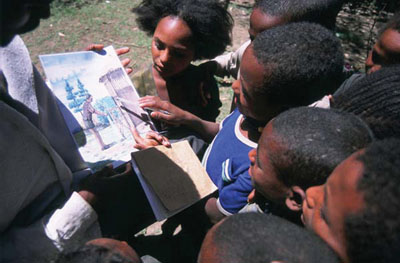
3.5.3 Sites for personal hygiene promotion
Whenever you have an outreach visit you can take the opportunity to promote personal hygiene to individual household members. Group meetings and mass gatherings (market, church, holiday) are also good opportunities, as are schools and patients in health facilities. Remember that the type and number of your audience will differ from site to site.
3.5.4 How to promote personal hygiene
This is a basic question that you need to address carefully. The most important point is that you must be prepared for the theme you want to cover. The preparation must focus on gaining detailed knowledge and adequate information on that theme. This requires reading materials, collecting appropriate teaching aids and knowing the audience (educational background, their needs, behaviour, habits, etc.). Fixing the site, date and time is also important. You should identify the key messages you want to get across to your audience.
3.5.5 Evaluating the status of personal hygiene
You will need to measure the success of your effort in the promotion of personal hygiene. It is not always a simple task to identify the absence of proper hygienic practice. Some of the methods that could be used widely are described as follows.
The presence of hygienic handwashing procedures
You should look for an instruction manual for handwashing procedures that should be available in public facilities (Health Post, health centre, hospitals). It’s a good idea for the procedure to be posted on a wall where everyone can see it as an easy reminder.
Observation
This is the easiest and most reliable method. In order to say if the surface of an object (body surface, eye, table top, floor, etc.) is clean or not, you should first understand what ‘clean’ means for those objects because the degree of cleanliness is judged in different ways. It may be clean or not clean; acceptable or not; or it may be categorised using a five-point scale: not clean, somewhat clean, clean, very clean, and super clean. You have to understand that the degree of cleanliness may vary between your own and someone else’s observations of the same object. Such judgement, however, is only applicable to visible dirt. It is important to realise that a surface that looks clean is not necessarily free of microorganisms.
Indirect way of assessing
You need to ask yourself why some infections are more prevalent in one village than another.
What could be the reason if you get reports that diarrhoea is a frequent problem in one out of ten villages?
You must suspect that poor personal hygiene practice might be one of the factors for the sustained transmission of the disease. Lack of adequate water for handwashing or open defecation could be other factors.
Post-baseline surveying
The behaviour of your community can be surveyed again to find out if your efforts in personal hygiene education have been successful. The design of any follow-up survey should be based on the original baseline survey so you can compare your survey findings with the baseline. The timing of a post-baseline survey will depend on the local circumstances. It should be long enough to allow time for behaviour to change but not later than one year after the initial survey.
Summary of Study Session 3
In Study Session 3, you have learned that:
- Personal hygiene is a necessity for our daily activities. It is very important for the protection of our health and helps to prevent the spread of communicable diseases.
- Personal hygiene has social and aesthetic values. An individual who follows the practice of proper personal hygiene gains confidence, pride and dignity.
- Personal hygiene applies to all parts of the body, but hand hygiene is probably the most important for public health.
- The procedures that apply in personal hygiene (such as handwashing and oral hygiene) need to be followed strictly to gain the best results.
- The promotion of personal hygiene should aim to change human behaviour. The provision of hygiene information first impacts on knowledge and then practice.
- The promotion of personal hygiene must be well planned in order to bring positive changes.
Self-Assessment Questions (SAQs) for Study Session 3
Now that you have completed this study session, you can assess how well you have achieved its Learning Outcomes by answering these questions. Write your answers in your Study Diary and discuss them with your Tutor at the next Study Support Meeting. You can check your answers with the Notes on the Self-Assessment Questions at the end of this Module.
SAQ 3.1 (tests Learning Outcomes 3.1 and 3.3)
Identify the components of personal hygiene that are numbered in Figure 3.9.
Answer
1 Hair hygiene; 2 Face hygiene; 3 Body hygiene; 4 Hand hygiene; 5 Feet hygiene; 6 Nail hygiene; 7 Armpit hygiene; 8 Oral hygiene; 9 Eye hygiene.
SAQ 3.2 (tests Learning Outcome 3.3)
Write the names of one or two communicable diseases or conditions and the recommended frequency of washing or cleaning for the following respective components of personal hygiene.
| Components | Diseases/conditions | Recommended frequency of cleaning |
|---|---|---|
| Eye hygiene | ||
| Hair hygiene | ||
| Body hygiene | ||
| Oral hygiene | ||
| Feet hygiene | ||
| Hand hygiene | ||
| Clothes hygiene |
Answer
| Components | Diseases/conditions | Recommended frequency of cleaning |
|---|---|---|
| Eye hygiene | Trachoma, conjunctivitis | Daily every morning and when the face is dirty |
| Hair hygiene | Dandruff, Tinea capitis, infestation (lice, nits) | Twice weekly; preferably once every other day |
| Body hygiene | Bad smell, scabies | Once or twice a week |
| Oral hygiene | Tooth decay, gum infection, bad breath | Brushing twice a day; rinsing after each meal |
| Feet hygiene | Athlete’s foot, wound | Every day |
| Hand hygiene | Diarrhoea, typhus fever, dysentery, ascariasis | Every time after touching contaminated surfaces; every time before eating and touching clean surfaces |
| Clothes hygiene | Bad smell, unclean, relapsing fever, typhus | Once or twice a week |
SAQ 3.3 (tests Learning Outcomes 3.2 and 3.5)
Given your answer for SAQ 3.2, which components are most important for your locality?
Answer
Your choice of components of personal hygiene depends on the burden of communicable diseases in your area. If diarrhoea and trachoma are prevalent in your locality, then hand and eye hygiene will be important to you. Many other answers are possible.
SAQ 3.4 (tests Learning Outcomes 3.4 and 3.6)
One day at a wedding, you observe some guests lining up for handwashing, while other people have started to eat the feast without handwashing. Among those who washed hands, some used soap, while others just used running water without soap. Are these acceptable or poor handwashing practices?
Answer
Handwashing with soap is a good or acceptable personal hygiene practice, while not washing with soap and only washing with running water is poor handwashing practice. Not washing the hands at all is obviously not good!
SAQ 3.5 (tests Learning Outcome 3.6)
The purpose of handwashing is to get rid of microorganisms from our hands. Suppose you want to educate family members on proper handwashing and demonstrate the correct procedure to follow. What will you tell them to do? What are the critical situations for proper handwashing they should be aware of?
Answer
The stepwise procedure is:
- Remove visible dirt with running water. Always wash hands under running water, preferably with hot water.
- Apply soap after wetting the hands. Bar, powdered and liquid soaps can be used. Lather well.
- Rub hands vigorously together for 15–30 seconds, paying particular attention to fingertips, thumbs, under the fingernails and between the fingers. Effective handwashing also includes the backs of the hand, palms and exposed portion of the arm.
- Rinse the hands with clean running water.
- Dry with a clean cloth or disposable towel, or let them dry in the air.
Critical situations include:
- After using the toilet (or disposing of human or animal faeces).
- After cleaning a child’s bottom.
- Before preparing or handling cooked/ready-to-eat food.
- Before eating food or feeding children.
- Before and after coming in contact with an infected wound.
SAQ 3.6 (tests Learning Outcome 3.7)
SAQ 3.5 addressed educating household members. What activities would you consider for the planning of personal hygiene promotion at community level?
Answer
Here are some of the elements and activities you should include in your plan for community hygiene promotion:
- Identify which components of personal hygiene need to be promoted.
- Identify the target audience.
- Prepare teaching and educational materials.
- Identify who to involve in hygiene education.
- Engage actively in hygiene education.
- Identify indicators for monitoring and evaluating hygiene promotion performance.
SAQ 3.7 (tests Learning Outcome 3.8)
Go back to SAQ 3.5 and your answer. Imagine that you have given this handwashing promotion to a group of households. How will you evaluate whether the promotion was effective?
Answer
To monitor and evaluate the effectiveness of your promotion, you would need to identify indicators to show you if the performance of personal hygiene was correctly done or not. You would need to observe people’s behaviour towards handwashing or ask them about their practice. If you can see that the household members are handwashing before and after critical times, i.e. good hygienic practice, then you could say your promotion had been successful. If not, and you observed poor hygienic practice by some people, then you should consider how you might improve the situation. This might be more promotional work with the group of households, perhaps taking a slightly different approach if the initial training had had limited success.
